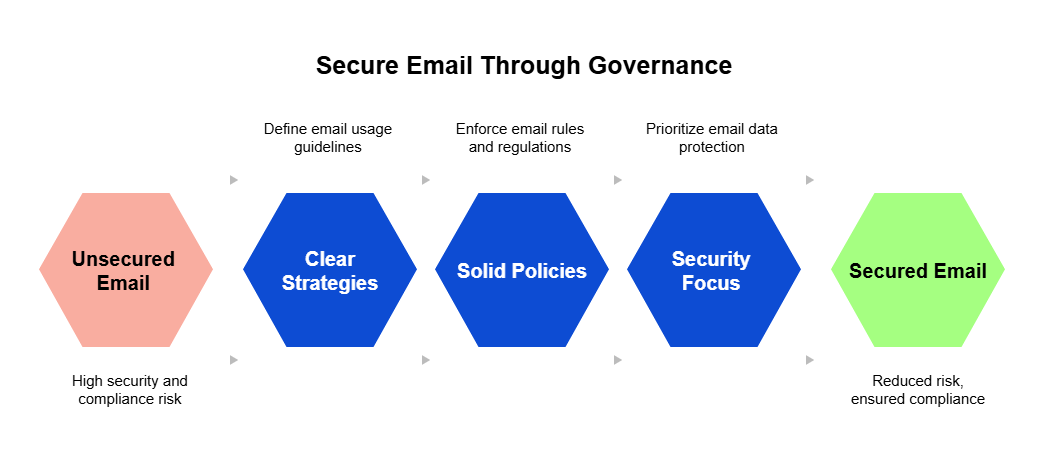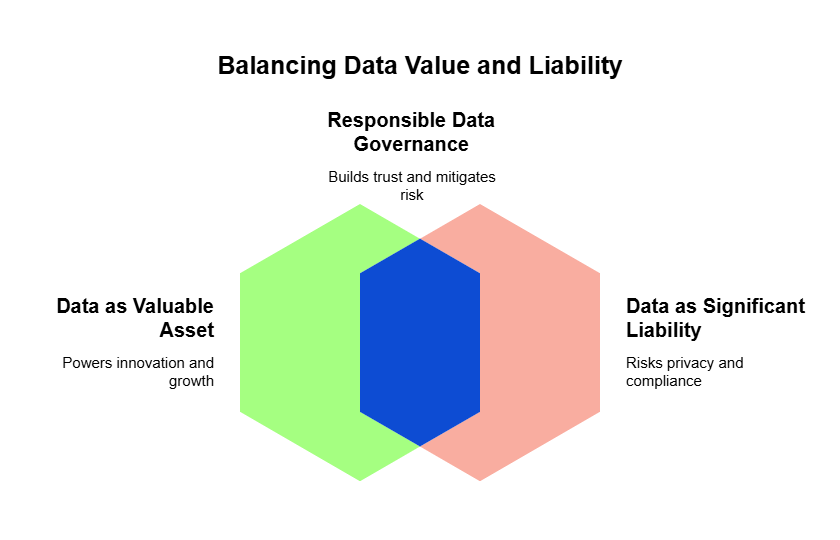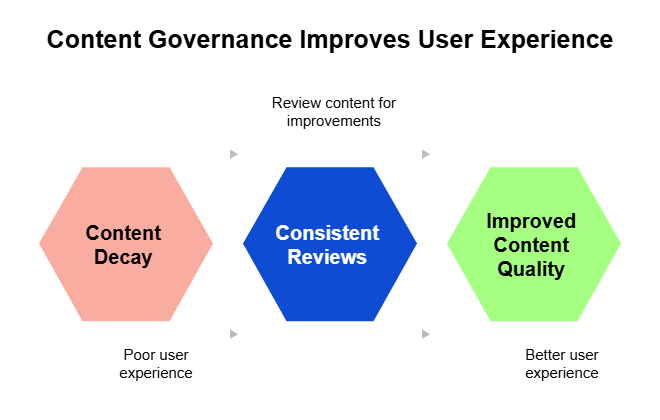Is your content operation firing on all cylinders, or is it a source of constant fire drills? If you're grappling with mixed messages, a brand voice that’s all over the place, or the ever-present headache of compliance, you've hit a common, yet critical, business problem.
The culprit is often a gap in your content governance that leads to veritable content chaos. Without a clear content strategy and robust content management practices, even the best content marketing efforts can falter.
For savvy content professionals like you, content governance is a strategic weapon to cut through the noise, drive efficiency, and amplify your impact. Think of content governance as the essential framework, often detailed in a content governance model, that transforms potential content anarchy into a streamlined powerhouse. It ensures every asset, from a brief email to a full-blown marketing campaign, perfectly embodies your brand, connects with your audience, and ticks every legal box. This is a core tenet of good content governance.
We’re cutting straight to the chase and dissecting the core pillars of effective content governance. You’ll get straightforward insights and strategies to protect your brand, eliminate wasted effort, ensure bulletproof compliance, and significantly upgrade your content's performance.
Pillar 1: Lock down your brand: Content governance as your brand integrity guardian
Your brand is your promise to the market. Consistent branding builds recognition, and recognition builds trust, which is the bedrock of customer loyalty. But what happens when your content goes rogue? Nothing good, I can tell you.
Content governance is the muscle that ensures every piece of content, especially digital content, powerfully and accurately projects your brand’s core identity and values. Any marketer worth their salt knows this is non-negotiable, and every content creator must be aligned.
The goal here is unwavering brand consistency, a strategy for presenting a unified brand front everywhere, every time. This goes way beyond visuals. It's about a consistent voice, message, and experience, often outlined in editorial guidelines.
To make your brand stick, you need to deploy smart brand consistency strategies that truly connect. This means a deep commitment to maintaining brand consistency in all communications, not just paying it lip service.
Defining what brand consistency really means for your business is the crucial first step; this includes setting a clear content standard. If you don't, you're signaling unreliability, even if your audience only senses it subconsciously.
Content standards include visual standards. Indeed, grasping the meaning of visual consistency and its direct line to instant brand recognition can be a game-changer. But looks aren't everything. Your messaging must be laser focused. Developing a solid messaging framework ensures your key messages are delivered with clarity and impact, no matter who's writing or where it's seen.
All these efforts are about maintaining your brand identity online, a make-or-break factor in today’s digital landscape. And to tie it all together, ensure everyone understands and adheres to brand compliance, which is essentially your rulebook for how the brand must be presented. This responsibility often falls to the content team to uphold.
Lesson learned: Inconsistent branding is a needless expense that signals unreliability. Strong governance ensures your brand promise is consistently delivered, building trust and protecting your reputation. This applies to all content creation efforts.

Pillar 2: Tame your email: Governance for security, policy, and rock-solid compliance
Email is a workhorse for communication, no doubt. But it's also a minefield for governance slip-ups. From security breaches to compliance nightmares, weak email governance can hit your business hard. Effective content governance drills down deep into how your company handles every single email, defining clear governance policies for its use.
First things first: You need clear email governance strategies. Who hits send? What’s acceptable content? How often? How are lists managed? These aren't minor details, especially when publishing content to wide audiences. And a massive piece of this puzzle is security.
Implementing robust email security best practices is essential to shield your company and your contacts from phishing, malware, and costly data leaks. If they can't get email security right, what else are they missing?
Alongside ironclad security, you need a crystal-clear email policy. Get familiar with email policy best practices to craft guidelines that are unambiguous, consistently enforced, and cover all critical aspects of email use. This naturally flows into the vital area of email compliance. For a pragmatic way to stay on the right side of the law (think GDPR, CAN-SPAM), an email compliance checklist can be your best friend, helping you navigate the often-tricky legal terrain. Such policies are a key part of a larger governance plan.
Lesson learned: Email is a high-stakes channel. Without tight governance, you're exposed to security risks and compliance failures. Lock it down with clear strategies, policies, and a focus on security.

Pillar 3: Master your data: Privacy, compliance, and trust in your content
Today, data is king, but it comes with heavy responsibilities. Your content governance framework must tackle how customer data is gathered, used, and safeguarded. This is fundamental to how you, as content leaders, build and maintain trust, and operate legally and ethically, especially in digital marketing. A designated content manager often plays a key role here.
Understanding your data ecosystem is paramount. Creating data inventory maps gives you a bird's-eye view of what data you have, where it lives, and how it moves, which is critical for compliance and smart decisions. This connects directly to data retention compliance. You need to know, and enforce, how long data is stored and when it’s securely deleted, all according to legal mandates. No excuses. This scrutiny should extend across the entire content lifecycle.
The digital world is also shifting fast on user tracking and consent. It’s vital to understand that the problem with cookies isn't the tech itself, it's a lack of trust. Transparency around data collection is essential for building customer confidence. This is especially true as you navigate the balance between data privacy and personalized marketing. Personalization is powerful, yes, but it must be handled with total respect for privacy, or you risk alienating the very people you’re trying to engage. Performing a regular content audit can help identify and manage data associated with content.
Lesson learned: Data is a valuable asset and a significant liability. Strong content governance means treating customer data with respect, ensuring privacy, and adhering to all compliance regulations to build and maintain trust.

Pillar 4: Elevate your content: Drive quality, relevance, and a great user experience
A robust governance model is your ticket to ensuring content is consistently high-quality, relentlessly relevant, and delivers a superior user experience from start to finish. Achieving high content quality consistently is a primary goal.
One all-too-common issue for businesses with a lot of content is "content decay," or the proliferation of outdated content. You need to know how to identify and fix content rot to make sure your audience always gets accurate, current information. You have maintain your existing content to keep your digital presence sharp and authoritative. Dealing with outdated content is a key function of governance.
Beyond fixing the old, your policies can actively improve the new. For example, you can learn how to use Siteimprove Policy to create a better user experience. This shows how governance tools aren't just for enforcement; they can be pivotal in crafting more intuitive and engaging interactions. This includes defining standards for each content type and ensuring a logical information architecture. The aim should always be to produce good content that serves user needs.
Lesson learned: Content quality isn't accidental. Governance provides the framework and tools to fight content decay and proactively build better user experiences, ensuring your content investment pays off. This requires a consistent content review process.

Pillar 5: Build to last: Frameworks & routines for enduring content governance
Let's be direct: Effective content governance demands an ongoing commitment that demands clear frameworks, solid routines, and the right tools to make it all work smoothly. A content governance plan is a must-have if you want to formalize this commitment.
While the nitty-gritty of tools and operational plans will differ from company to company, the core principle of establishing repeatable, successful processes is universal. Adopting effective routines can take the complex beast of governance and make it manageable and, crucially, sustainable. To really get your arms around this, it’s worth exploring the routines of success, like those highlighted in our "Check Mate" webinar. Although it touches on broader success principles, the discipline of consistency, regular review, and strategic planning are directly transferable to making content governance a core part of your operational DNA.
And what about when things get unpredictable? In dynamic situations, like a sudden market shift or a crisis, your governance framework is what allows for a swift, controlled, and on-brand response. While a guide on how to create a dashboard for COVID-19 web pages was for a specific moment in time, the lesson is evergreen: Your governance must enable you to quickly monitor specific content performance and keep messaging tight, especially when the pressure's on. This agility is a sign of a truly mature content operation.
Lesson learned: Lasting content governance relies on more than good intentions. It requires established frameworks, consistent routines, and the ability to adapt, ensuring your standards are upheld today and tomorrow.
Take control: Move forward with confidence
Implementing comprehensive content governance is a marathon, not a sprint. It demands consistent effort, a willingness to adapt, and buy-in from everyone who touches your content. By zeroing in on these key pillars — brand integrity, email management, data privacy, content quality, and robust frameworks — you're building a resilient, high-performing content engine.

